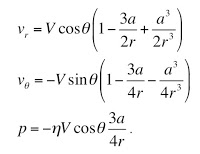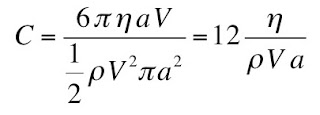| Online: | |
| Visits: | |
| Stories: |

| Story Views | |
| Now: | |
| Last Hour: | |
| Last 24 Hours: | |
| Total: | |
Stokes' Flow around a Sphere
When working on the 5th edition of Intermediate Physics for Medicine and Biology, Russ Hobbie and I added a new homework problem about low Reynolds number flow. We ask the reader to analyze the classic example of “Stokes' flow” or “creeping flow” around a sphere.
Problem 46. Consider a stationary sphere of radius a placed in a fluid of viscosity η moving uniformly with speed V. For low Reynolds number flow, the radial and tangential components of the fluid velocity and the pressure surrounding the sphere are(a) Show that the no-slip boundary condition is satisfied.
(b) Integrate the shear force and the pressure force over the sphere surface and find an expression for the net drag force on the sphere (Stoke’s law). What fraction of this force arises from pressure drag, and what fraction from viscous drag?
(Everywhere else in our book we correctly write “Stokes’ law” since the law is named after Sir George Stokes, but in this problem we slip up and write “Stoke’s law”. Sorry. I noted this in the errata available on the book website.)
After solving this problem, the reader is probably thinking “this is all well and nice, and I understand now how you get Stokes’ law from the pressure distribution and the viscous drag, but where in the world did you get those weird velocity and pressure distributions?”
First, this example applies to a sphere in water, and water is nearly incompressible. Problem 1.35 shows that incompressibility implies that the velocity u has zero divergence,
The reader should pause now, look up the expression for the divergence in spherical coordinates, and verify that the given velocity really is divergenceless.
Second, the equation describing flow is the Navier-Stokes equation, which is really nothing more than Newton’s second law (F=ma) applied to the fluid. Problem 1.28 provides some insight by deriving a simplified form of the Navier-Stokes equation
If we assume a low Reynolds number, we can ignore the two terms on the left-hand side of this equation because they are “inertial” terms arising from the acceleration of the fluid. The two terms on the right-hand side can be generalized to three dimensions, with the pressure term containing the gradient of the pressure and the viscous term containing the Laplacian of the velocity. The resulting Navier-Stokes equation is
To get the expressions given in the new Problem 1.46, solve the Navier-Stokes equation assuming an incompressible fluid. In addition, the boundary conditions are 1) far from the sphere (r much greater than a) the flow is entirely along the z-axis with speed V, and 2) at the sphere surface (r = a) the radial component of the velocity vanishes because the flow is incompressible and the tangential component of the velocity vanishes because of the no-slip boundary condition.
Stokes’ law for the net drag force, derived in part b) of Problem 1.46, is F = 6πηaV. Often the drag force is described by a dimensionless coefficient called the drag coefficient, C, equal to F divided by ½ ρ V2 π a2. For creeping flow around a sphere, the drag coefficient is
Using the definition of the dimensionless Reynolds number, Re (Eq. 1.62 in IPMB), we find that C = 12/Re. Often the Reynolds number is written in terms of the diameter of the sphere rather than the radius, in which case we get the more commonly quoted relationship C = 24/Re. In many fluid dynamics textbooks you will see C plotted versus Re (usually on log-log graph paper). At low Reynolds number C is inversely proportional to Re as creeping flow predicts. At high Reynolds number the relationship between C and Re is more complex because a turbulent boundary layer forms near the sphere surface. But that’s another story.
Source: http://hobbieroth.blogspot.com/2015/11/stokes-flow-around-sphere.html








